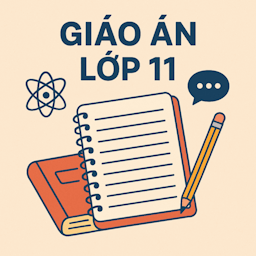Giáo án tiếng Anh lớp 11 Tuần 10 sách mới
Giáo án tiếng Anh lớp 11 chương trình mới Tuần 10
Giáo án tuần 10 môn tiếng Anh lớp 11 sách mới nằm trong bộ tài liệu Giáo án môn Tiếng Anh 11 theo tuần do VnDoc.com sưu tầm và đăng tải. Nội dung giáo án tiếng Anh gồm 2 tiết Review Unit 1 - 3 và Lesson 1 Getting Started Unit 4 Caring for those in need. Mời quý thầy cô tham khảo, download tài liệu.
Date of preparation:
Date of signing:
Period 28+29:
REVIEW 1
I. Objectives
By the end of the lesson, students will be able to:revise the language and skills they have learnt in units 1-3.
1. Knowledge
+ Vocabulary: Words / phrases related to topics “The generation gap”, “Relationships”, and “Becoming independent"
+ Pronunciation: strong and weak forms of words in connected speech; linking.
+ Grammar: Modal verbs, Linking verbs, Cleft sentences, and To infinitive.
2. Skills
- Listening, reading, speaking, writing
3. Attitude
- have responsible attitude towards their study and life.
II. Teaching method:Integrated, mainly communicative
III. Teaching aids
- CD & CD player, board, chalks, textbook and notebook.
IV. Procedure
1. Class organization:
|
Date |
Period |
Class |
Attendance |
Absentees/Notes |
|
….. __ / __ / __ |
|
|
…. / …. |
|
|
|
|
|
|
|
2. Previous lesson check:
- during the new lesson.
3. New lesson:
|
T’s and Ss’ Activities |
Knowledge |
|
1. Form compound nouns with the words in the box. Then complete the sentences using the correct ones. - Ask Ss to do this activity individually, and then compare their answers with a partner. Check answers as a class and write the correct ones on the board.
2. Complete the sentences with correct words from the box. - Have Ss do this activity individually. Then ask a student to write his / her answers on the board. Check the answers with the whole class.
3. Listen and link the final consonants and initial vowels in the sentences. Then read them aloud. - Play the recording and have Ss do this activity individually, and then compare their answers with a partner. Write the sentences on the board. Then ask Ss to practise reading the sentences aloud.
4. Complete these sentences with should/ shouldn't/ought to/ought not to/must/ mustn't/have to/has to. - Elicit the form and use of the modals: should/ shouldn't/ought to/ought not to/must/mustn't/ have to/has to. - Ask a volunteer to do the activity on the board while the rest of the class works on it individually. - Check Ss' answers, and ask Ss to provide explanations for their choice of modals if necessary. 5. Rewrite the following sentences to emphasise the underlined parts using It is/was... that. - Elicit the form and use of the sentence structure It is / was... that.... - Have Ss do this activity individually, and then compare their answers with a partner. - Ask a student to write his / her sentences on the board. Check the answers with the whole class.
6. Write new sentences with a similar meaning. Use the to-infinitive after the adjective. - Elicit the use of the to-infinitive. - Ask Ss to do this activity individually, and then compare their answers with a partner. - Write the correct answers on the board.
|
LANGUAGE Vocabulary Activity 1. 1. housework 2. childcare 3. viewpoint 4. grandparents 5. girlfriend
Activity 2. 1. relationship 2. an argument 3. reconciled 4. independent 5. self-reliant Pronunciation
Activity 3. 1. Kate is a teacher of English in an upper secondary school. 2. Look at these pictures and answer my questions in English. 3. Tom used to live in his parents' house, but he' s moved into a new flat with some friends 4. Can I have a cup of apple tea? 5. Don' t forget to turn off the lights when you leave after the party.
Grammar Activity 4. 1. should / ought to 2. shouldn't / ought not to 3. must / have to 4. mustn't 5. must / has to
Activity 5. 1. It was in Greece that the first Olympic Games were held. 2. It was Nam who / that won the first prize in the English speaking contest. 3. It' s a chocolate cake that I am making for my best friend' s birthday party. 4. It was in 1759 that Scotland' s most famous poet Robert Burns was born. 5. It' s working on a computer that gives me headache. Activity 6. 1. Our school is quite easy to find. 2. The paragraph is difficult to translate. 3. I am delighted to work for the school library. 4. She was very surprised to see him at the party. 5. I was sorry to hear that your grandma was ill. |
|
1 and 2. Read and complete the text with the words from the box, then answer the questions.
Ask Ss to complete Activities 1 and 2 individually and compare their answers with a partner. Then give the correct answers and any explanations if necessary.
3. Work with your partner. Make a conversation about your friend' s problem and give them advice. Use your own ideas or the suggestions below. - Ask Ss to work with a partner to make a conversation about a friend' s problem. One student explains the problem while the other asks questions and offers advice. Ss may use their own ideas or the suggestions. - Encourage Ss to swap roles and role-play the conversation again.
4. Listen to recording about relationship problem between parents and teenage children. Decide whether the following statements are true (T) or false (F) according to the speaker. - Play the recording once for Ss to listen and choose their answers. - Play the recording again pausing at appropriate places and highlighting the clues in the listening text, so Ss can check their answers. Then give the correct answers, for weaker Ss. - Play the recording several times pausing after sentences to check Ss’ comprehension.
5. Read the advertisements and choose one of the language schools you want to attend to improve your English. - Ask Ss to read the two advertisements and choose one of the language schools they would like to attend to improve their English. 6. Write a letter requesting more information I about the language courses. You can ask about the starting date, course duration, teachers experience, fees and course certificate. - Ask Ss to write a letter requesting more information about the language courses. Ss may write their drafts first in class, swap them with a partner for peer review, and write their final version at home.
|
SKILLS Reading Activity 1. 1. decisions2. hopefully 3. unemployment 4. advantage 5. straight 6. qualifications 7. possibility 8. practical Activity 2. 1. Around the age of seventeen. 2. There is more unemployment. 3. Getting a job more easily. 4. There are many opportunities for training. Speaking Activity 3. Your friend' s problem: - getting bad exam results Your advice: - spend less time surfing the Internet for pleasure - spend more time searching information for assignments - work harder - ask a teacher for extra tuition
Listening Activity 4. 1. T 2. F 3. T 4. F 5. T
Writing
Sample letter: Dear Ms Smith, I saw your advertisement about the language courses on your website. I am interested in learning English, and I am writing to enquire about the English courses at your centre. I can read and write in English, but I can' t speak the language very well. If necessary, I can complete an oral test. I want to improve my pronunciation, and hope to be able to practise my English with native speakers. I would also like to have more information about the starting date, course duration, teachers' experience, fees and course certificate. I look forward to hearing from you. Yours sincerely, |
4. Consolidation:
- Summarize the main points:
+ revise the language and skills they have learnt in units 1-3.
5. Homework:
- practice the tasks.
- prepare for the next lesson
--------------------------------------------------o0o--------------------------------------------------
Date of preparation:
Date of signing:
Period 30:
UNIT 4: CARING FOR THOSE IN NEED
Part 1: Getting started
I. Objectives
By the end of the lesson, students will be able to:
1. Knowledge
- Get to know the topic: vocabulary about people with disabilities; the past simple and the present.
(Lexical items: disability, blind, deaf, dumb, get around, integrate, campaign, charity, donate.
2. Skills
- Listening, reading
+ Scanning for specific information to answer questions
+ Identifying the meaning of words depending on the context
3. Attitude
- have responsible attitude towards helping people with disabilities.
II. Teaching method:Integrated, mainly communicative
III. Teaching aids
- CD & CD player, board, chalks, textbook and notebook.
IV. Procedure
1. Class organization:
|
Date |
Period |
Class |
Attendance |
Absentees/Notes |
|
….. __ / __ / __ |
|
|
…. / …. |
|
2. Previous lesson check:
- during the new lesson.
3. New lesson:
|
T’s and Ss’Activities |
Knowledge |
|
Lead-in: T: Inform the class of the lesson objectives Introduce the topic by asking Ss to talk about the photos of people with disabilities. Then elicit more ideas from Ss’ background knowledge. Encourage Ss to talk about disabled people’s achievements. Tell them to include respect for disabled people and donation to charities in their discussion. Ss: Listen and answer Talk about disabled people’s achievements; include respect for disabled people and donation to charities in the discussion.
T: Ask Ss questions about the illustration: Tell Ss that that are going to listen to a conversation in a school library between three friends: Mai, Kevin and Maria. Let Ss predict what these friends will be talking about. Encourage and accept all types of predictions from Ss. Play the recording. Ask Ss to listen and read the conversation at the same time. Ss: Answer the questions: Listen Predict what these friends will be talking about. Listen and read the conversation at the same time.
T: Asks Ss to work first individually, and then in pairs to decide whether the statements are True(T) or False(F), or not given(NG). ss can provide their answers. They may refer back to the conversation to get the necessary information. Checks sts’s answers and give explanation. Ss: Work in pairs to practice asking and answering the questions Give explanation Read the question and example and think of their own answer to the question. Work individually first, then with a partner. Give answers
Have sts read the question and example. Ask them to think of their own answer to the question. Sts work individually first, then with a partner. Elicit some answers and writes the best ones on the board. Give feedback and discuss any points. |
1. Activity 1: Who do you see in the picture? What are they doing? What do you think they are going to do with the gift?
2. Activity 2: 1. T 2. F 3. NG 4. T 5. NG
3. Activity 3: Ss’ answers may vary |
4. Consolidation:
- Summarize the main points:
+ Get to know the topic: vocabulary about people with disabilities; the past simple and the present.
5. Homework:
- practice the tasks.
- prepare for the next lesson
Trên đây là giáo án tuần 10 môn tiếng Anh lớp 11 mới.
Xem thêm giáo án tiếng Anh 11 cả năm tại: Giáo án tiếng Anh lớp 11 mới thí điểm trọn bộ năm học 2019 - 2020. Mời thầy cô tham khảo thêm nhiều tài liệu ôn tập Tiếng Anh lớp 11 cả năm khác như: Để học tốt Tiếng Anh lớp 11, Bài tập Tiếng Anh lớp 11 theo từng Unit trực tuyến, Đề thi học kì 1 lớp 11, Đề thi học kì 2 lớp 11,... được cập nhật liên tục trên VnDoc.com.





